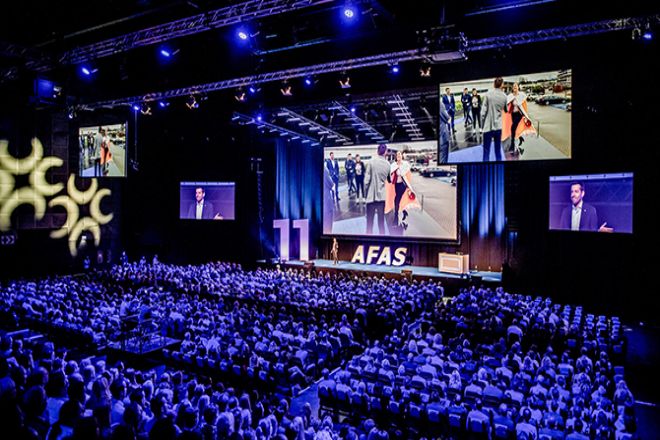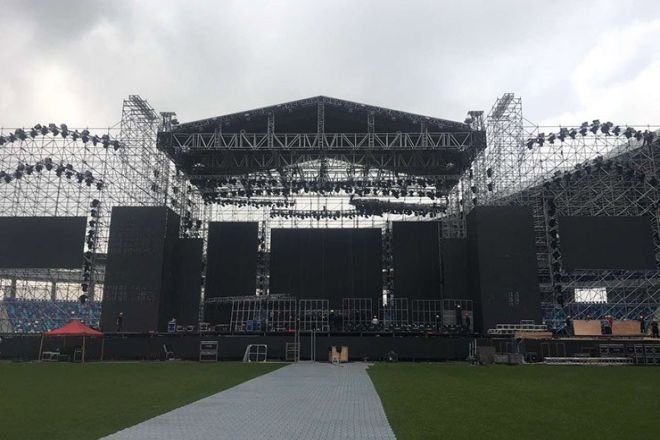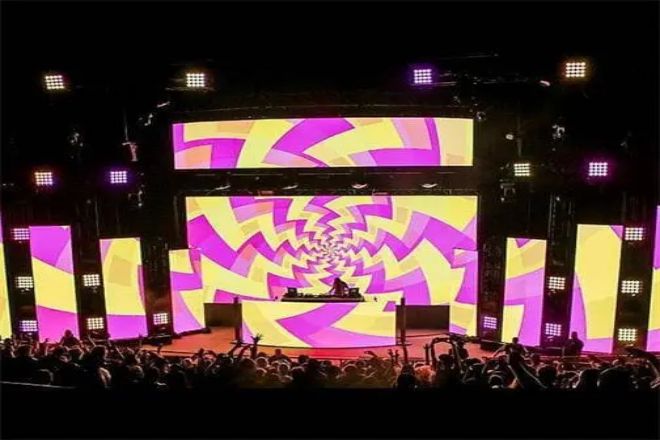소개

In the field of modern performing arts and activities, stage LED displays have become an indispensable and important element. They can not only attract the audience’s attention with shocking visual effects but also add unlimited possibilities to activities through dynamic images, real-time interaction, and other functions.
From large-scale concerts to corporate press conferences, from indoor theaters to outdoor squares, the wide application of stage LED displays not only enhances the viewing experience of the event but also greatly enriches the expression of stage art.
However, the construction of stage LED displays is not easy. It involves complex engineering technology, precise dimensional measurement, meticulous installation and debugging, and strict safety regulations.
A successful stage LED display construction project requires not only a professional team and advanced equipment but also attention to detail and a deep understanding of technology.
1. Preliminary preparation

In the initial stage of the construction of the stage LED display, sufficient preliminary preparation is the key to ensure the smooth progress of the project. The work at this stage mainly includes determining needs and planning as well as the preparation of materials and equipment.
1). Determine needs and plan
- Clear purpose:
First, it is necessary to determine the main functions and display the content of the LED display according to the specific type of event (such as large-scale concerts, new product launches, art exhibitions, etc.).
Different types of activities have different requirements for the resolution, brightness, color reproduction, and other performance parameters of the display screen.
- Site inspection:
Next, a detailed inspection of the event venue will be conducted. This includes measuring the size, height, and load-bearing capacity of the stage to ensure that the installation of the LED display screen will not exceed the load-bearing capacity of the stage.
At the same time, it is also necessary to understand the power supply, network, and other infrastructure in the venue to prepare for the power supply and data transmission of the display screen.
- Design plan:
After clarifying the needs and site conditions, start designing the specific plan for the LED display screen.
This includes determining the specifications of the display screen (such as screen size, and resolution), layout (such as single screen, multi-screen splicing, arc or special shape, etc.), and hoisting method (such as hoisting frame, ground support, etc.).
The design plan should fully consider factors such as the theme of the event, the audience’s perspective, and visual effects.
2). Material and equipment preparation
- Display screen module:
Select the appropriate LED display screen module according to the design plan. These modules are the basic units that constitute the entire display screen, and their quality directly affects the display effect.
When selecting, pay attention to the performance indicators of the module such as brightness, color consistency, and viewing angle.
- Brackets and fixing equipment:
Prepare corresponding brackets, hanging beams, fixing racks, and other installation equipment according to the design plan. These devices should have high strength and stability to ensure the safety of the display during installation and use.
- Power supply and control system:
Prepare enough power cords, control cards, connecting cables, control software, etc. These devices are the key to the normal operation of the display; the power supply should be stable and reliable, and the control system should be powerful and easy to operate.
- Auxiliary materials:
prepare necessary auxiliary materials, such as screws, straps, plexiglass (used to protect the surface of the display or make frames), stainless steel frames (to enhance the overall aesthetics of the display), etc. These materials will play an important role in the installation and debugging of the display.
2. Construction steps
After the preliminary preparation of the stage LED display is completed, the substantive construction stage will be entered. The work at this stage requires fine operation and strict control of each step to ensure the installation quality and final effect of the display.
1). Installation bracket
- Bracket manufacturing:
According to the actual situation of the site and the design drawings, accurately manufacture or select the appropriate bracket. The material, structure, and load-bearing capacity of the bracket must meet the weight and safety requirements of the display to ensure stability and reliability.
- Installation bracket:
Select a suitable position on the stage and use professional tools to fix the bracket on the ground or on the stage structure. During the installation process, special attention should be paid to the horizontal and vertical degree of the bracket, and tools such as a level should be used for precise measurement and adjustment to ensure the installation accuracy of the bracket.
2). Assembling the display screen
- 모듈 설치:
Place the LED display screen modules on the bracket one by one according to the predetermined arrangement.
During installation, it is necessary to ensure that the gap between each module is uniform and accurately aligned and use screws or other fixings to firmly fix the module on the bracket.
- Connecting lines:
Connect the power cord, data cable, and control card on the display screen. During the connection process, it is necessary to carefully check whether the connectors of each line are firm and not loose and avoid problems such as poor contact or short circuit.
At the same time, it is also necessary to pay attention to the direction and layout of the line to ensure that it is neat and beautiful and does not affect the display effect of the display screen.
- Preliminary debugging:
After the display screen module is installed and the line is connected, preliminary debugging work is carried out.
Send a signal through the control software to check whether the display screen can be lit normally and observe whether its display effect meets the expected requirements. If there is a problem, it needs to be checked and solved in time.
3). Hoisting and adjustment
- Selection of hoisting method:
Select a suitable hoisting method according to the size, weight, and site conditions of the display screen. Common lifting methods include gear type, cone-rod type, bolt type, etc., which need to be selected according to specific circumstances.
- Lifting operation:
Use professional lifting equipment (such as a crane, hoist, etc.) to lift the display screen to the predetermined position. During the lifting process, the display screen must be kept balanced and stable to avoid collision or tilting. After reaching the predetermined position, use ropes or fixings to firmly fix the display screen to the bracket.
- 각도 조절:
Adjust the installation angle of the display screen according to the on-site conditions.
This includes the adjustment of the horizontal angle and the vertical angle to ensure the best display effect of the display screen. The adjustment can be achieved by using an angle adjuster or manually adjusting the screws on the bracket.
4). Control system installation and debugging
- Install the control device:
Insert the control card into the control card slot of the display screen and connect it to a computer or other control device. When connecting, ensure that the interface matches, the connection is firm and correct.
- Software settings:
Install and set the LED display screen control software. Set the corresponding parameters such as brightness, contrast, color, etc. according to the model and specifications of the display screen.
At the same time, the software needs to be calibrated and debugged to ensure that it can accurately control the display effect of the display screen.
- Functional test:
After the control system is installed and set up, perform a functional test. Play the test video or picture to check the display effect and stability of the display.
Observe whether the picture is clear, smooth, and has no obvious defects; check whether the color reproduction, brightness uniformity, and other indicators meet the requirements.
At the same time, pay attention to whether there are any abnormal phenomena (such as flickering, black screen, etc.) during the operation of the display. If there are any problems, they must be checked and solved in time.
3. Safety and maintenance

In the construction, use and subsequent maintenance of the stage LED display, safety and maintenance are two crucial aspects. They are not only related to the stable operation and extended service life of the equipment but also directly related to the personal safety of the on-site personnel.
1) 안전수칙
- Operation specifications:
All staff involved in the construction, debugging, and use must strictly abide by the safety operating procedures.
This includes wearing appropriate protective equipment (such as helmets, gloves, protective shoes, etc.), using professional tools, and staying focused and cautious during operation. Any violation of safety regulations should be stopped and corrected immediately.
- Anti-vibration and anti-fall:
The stage LED display is susceptible to vibration and impact during transportation and installation, so it must have high anti-vibration performance.
Handle the display with care during transportation to avoid severe vibration; use professional lifting equipment and fixtures during installation to ensure that the display is stable and reliable.
In addition, excessive external force should be avoided on the display during the debugging and testing phases.
- Avoid touching:
The surface of the display is covered with a large number of LED wicks, which are very fragile and sensitive to static electricity.
Therefore, during the debugging and testing phases, try to avoid touching the surface of the display to prevent damage to the LED wicks or introduce static interference.
If necessary operations are required, professional tools and gloves should be used, and hands should be dry and free of static electricity.
2). Maintenance and care
- 정기점검:
In order to ensure the stable operation of the display and extend its service life, the display should be inspected regularly. This includes checking whether the fixings of the display (such as screws, brackets, etc.) are loose or damaged.
Checking whether the connecting cables (such as power cables, data cables, etc.) are in good contact and undamaged; and checking whether the various components of the display are operating normally. If problems are found, they should be handled in a timely manner, and damaged parts should be replaced.
- 청소 및 유지 관리:
Dust and stains easily accumulate on the surface and inside of the display, which will not only affect the display effect but also damage the equipment. Therefore, the surface and inside of the display should be cleaned regularly.
When cleaning, you should use professional cleaning agents and a soft cloth to wipe, and avoid using cleaning agents containing corrosive substances or hard objects to scratch the surface of the display. At the same time, you should also pay attention to keeping the environment around the display clean and dry to avoid moisture and mildew.
- Fault handling:
If you encounter common problems such as uneven brightness and pixel failure during use, you should handle them in time.
First, you should check the specific cause of the fault, such as loose connection wires, damaged LED wicks, etc.; then take appropriate measures according to the specific situation to deal with it, such as reconnecting the line, replacing damaged LED wicks, etc.
If you can’t handle it yourself, you should contact professional maintenance personnel in time for maintenance to ensure that the display can operate stably for a long time.
결론
In summary, the construction of stage LED display screens is a complex and delicate project, which requires us to be meticulous in every detail. Through the detailed analysis of this article, we understand the whole process from preliminary preparation to construction steps, to safety and maintenance, and master the key technologies and precautions for building stage LED display screens.
마지막으로 LED 디스플레이 화면에 대해 더 알고 싶다면, 우리에게 연락해주세요.
